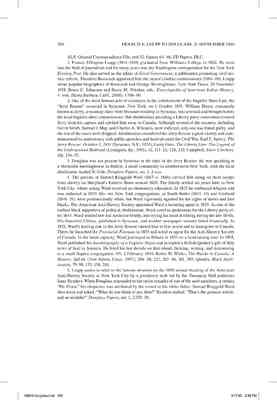Pages
page_0001
FRANCIS E. LEUPP1Francis Ellington Leupp (1841–1918) graduated from Williams College in 1862. He went into the field of journalism and for many years was the Washington correspondent for the New York Evening Post. He also served as the editor of Good Government, a publication promoting civil service reform. Theodore Roosevelt appointed him the nation’s Indian commissioner (1904–09). Leupp wrote popular biographies of Roosevelt and George Westinghouse. New York Times, 20 November 1918; Bruce E. Johansen and Barry M. Pritzker, eds., Encyclopedia of American Indian History, 4 vols. (Santa Barbara, Calif., 2008), 1: 768–69. TO FREDERICK DOUGLASS
Syracuse, N.Y. 21 Sept[ember 18]80.
TO/HON: FREDK DOUGLASS.
DEAR SIR:
I am collecting a few historical data respecting the famous “Jerry rescue”,2One of the most famous acts of resistance to the enforcement of the Fugitive Slave Law, the “Jerry Rescue” occurred in Syracuse, New York, on 1 October 1851. William Henry, commonly known as Jerry, a runaway slave from Missouri residing in Syracuse, was arrested and brought before the local fugitive-slave commissioner. But abolitionists attending a Liberty party convention rescued Jerry from his captors and spirited him away to Canada. Although several of the rescuers, including Gerrit Smith, Samuel J. May, and Charles A. Wheaton, were indicted, only one was found guilty, and the rest of the cases were dropped. Abolitionists considered the Jerry Rescue a great victory and commemorated its anniversary with public speeches and festivals until the Civil War. Earl E. Sperry, The Jerry Rescue: October 1, 1851 (Syracuse, N.Y., 1924); Larry Gara, The Liberty Line: The Legend of the Underground Railroad (Lexington, Ky., 1961), 42, 111–12, 128, 132; Campbell, Slave Catchers, 101, 154–57. which occurred here, I believe, on the 1st of October, 1851. I have been informed in one quarter that you were present in the city either on the occasion or shortly before it, & made a speech which did much toward inspiring the stroke for human rights.3Douglass was not present in Syracuse at the time of the Jerry Rescue. He was speaking at a Methodist meetinghouse in Belfast, a small community in southwestern New York, with the local abolitionist Asahel N. Cole. Douglass Papers, ser. 1, 2: xxx. Will you kindly inform me if this is true?
I am further informed that you once accepted the challenge of a certain white man in New York city to debate, he declaring that no colored man could argue with a white; and that, when you had disproved his brag, Sam Ward4The parents of Samuel Ringgold Ward (1817–c. 1866) carried him along on their escape from slavery on Maryland’s Eastern Shore around 1820. The family settled six years later in New York City, where young Ward received an elementary education. In 1833 he embraced religion and was ordained in 1839. His two New York congregations, at South Butler (1841–43) and Cortland (1846–51), were predominantly white, but Ward vigorously agitated for the rights of slaves and free blacks. The American Anti-Slavery Society appointed Ward a lecturing agent in 1839. As one of the earliest black supporters of political abolitionism, Ward acted as spokesman for the Liberty party after 1844. Ward studied law and medicine briefly, also trying his hand at editing during the late 1840s. His Impartial Citizen, published in Syracuse, and another newspaper venture failed financially. In 1851, Ward’s leading role in the Jerry Rescue caused him to fear arrest and to immigrate to Canada. There, he launched the Provincial Freeman in 1853 and acted as agent for the Anti-Slavery Society of Canada. In the latter capacity, Ward journeyed to Britain in 1853 on a fund-raising tour. In 1855, Ward published his Autobiography of a Fugitive Negro and accepted a British Quaker’s gift of fifty acres of land in Jamaica. He lived his last decade on that island, farming, writing, and ministering to a small Baptist congregation. NS, 2 February 1849; Robin W. Winks, The Blacks in Canada: A History, 2nd ed. (New Haven, Conn., 1997), 206–08, 227, 265–66, 361, 395; Quarles, Black Abolitionists, 79, 98, 133, 138, 210. accepted the challenge—the white man having declared that you were ruled out by reason of the white blood in your veins.5Leupp seems to refer to the famous invasion on the 1850 annual meeting of the American Anti-Slavery Society in New York City by a proslavery mob led by the Tammany Hall politician Isaac Rynders. When Douglass responded to the racist remarks of one of the mob members, a certain “Dr. Grant,” his eloquence was attributed by the crowd to his white father. Samuel Ringgold Ward then arose and asked, “What do you think of me, then?” Rynders replied, “That’s the genuine article, and no mistake!” Douglass Papers, ser. 1, 2: 235–36. Will you kindly write me whether this is true; what the subject of debate was; and what was the name of your antagonist and challenger.
I should not trespass on your valuable time to ask these questions, but for the fact that so many conflicting particulars are afloat that I am driven to original sources for accurate statements wherever such sources can be reached.
In haste, I am
Very sincerely yours—
FRANCIS E. LEUPP

